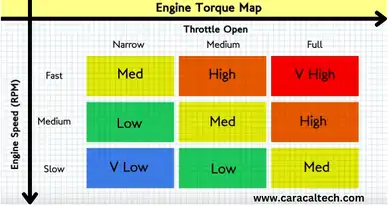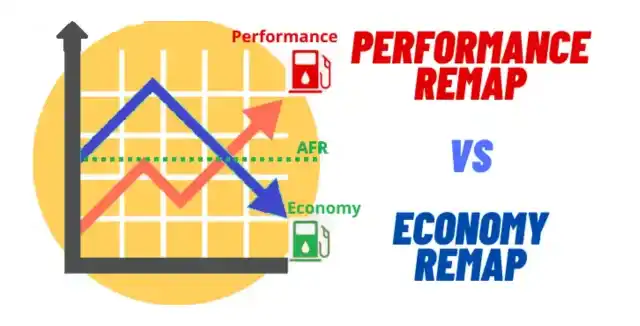What is The Difference Between a Performance Remap & an Economy Remap?
First of all, we want to tell you that what is ECU Remapping. ECU Remapping is a modified software setting which will be replaced with the original ECU software in order to increase power, torque and in some cases improve the fuel consumption. Remap prepares the car to achieve the maximum efficiency in the safest way possible and as you may already know the ECU completely controls the car engine therefore, when you remap the ECU, it will have significant effects on acceleration, fuel consumption, engine knock and etc. In Remapping, we Remap the tables that are in the car's ECU and depending on the software of your car’s ECU, the ECU will be full of maps for different things such as, Spark Advance, Lambda etc. In fact, it has been done individually and we program remaps by purpose to accommodate for the specific needs of each vehicle, the exact results will be assessed depending on the make, model and year of your car.
What are Engine Maps?
We hear a lot about Engine Maps and modes that Tuners often change and fiddle with either independently or at the behest of their engineers. So, we want to find out what Engine maps are and how they affect the way the cars work. Let's start with the basics.
On the way back, when the accelerator pedal was directly physically connected to the engine throttle via mechanical cable. The more you pushed your foot to the pedal, the more the throttle opened and let more air and fuel into the engine cylinders which drove more power from the engine via increased combustion.
It was simple, but it was limited. Nowadays, the amount of travel in the accelerator pedal is measured electronically and read by the “Electronic Control Unit” or ECU. The ECU then takes in lots of other inputs from the car and works out exactly how to manage the combustion part of the engine and ultimately the power output. It works all this out via Engine Maps. Engine Maps are essentially a bunch of data tables in which the ECU looks at what's going on with the car and driver inputs in order to find out what it's supposed to do with the engine.
To get a feel for this, let's start with the Engine Torque Map which is really more of the lay of the land than a series of instructions, but it all fits into the wider picture. The Engine Torque Map just describes how much torque the engine delivers as standard at a given RPM and amount of throttle. Your inputs are the RPM (The rotational speed of the engine) and throttle level (Basically, how much fuel mixture you're pumping into the engine). The torque (Which is strictly how much turning force the engine is producing) is an output. So, if you know your RPM and throttle level, the map will tell you the engine torque.
So, let's imagine a very simple scaled-down version of this Engine Map. We could model it to see what would happen at slow, medium and fast RPM’s. And we can also look at narrow, medium and full throttle levels.

This gives us a nice table with nine possible scenarios, which are the outputs. So, if the engine is running at low RPM and we're only squeezing the throttle a little, the map tells us the engine will be producing a small amount of torque. Full throttle at high RPM, produces a large amount of torque and so on. Now, obviously the Engine Maps used in real life are a lot more granular than that, by using more than just our three gradations of input. So, this Engine Torque Map just describes the engine as it normally behaves. We can gather this data by running the engine on a testing dyno and logging its torques levels under different scenarios.
But What if We Wanted To Create a Map that Makes it Behave Differently To Normal?
That’s where a Performance Remap is different from an Economy Remap. This is where our custom, various engine maps come in. We can create our own versions of these maps so that, when a driver pushes the accelerator pedal at a certain engine speed, the torque output will be different under different Maps. Actually, it depends on the customer's needs. For example, we might want to increase the Air/Fuel Ratio at lower REVs because we want to improve the fuel consumption. Because the customer doesn't need the most power of the engine. In the Tuning world, we call it “Economy Remapping”. On the other hand, we may want to make the jump from low to high torque more dramatic or decrease the Air/Fuel ratio in order to get the most out of the engine. Which is called “Performance Remapping”.
The idea behind these maps is that we're going to demand from the engine a certain amount of torque or power by given certain scenarios. We're going to tell the engine, if I’m pushing the throttle halfway and you're revving at 7000 RPM, then you better give me 180 Newton Meters of torque or whatever. So, imagine you're the driver and when you adjust the pedal with your foot you'll have an expectation of what the engine does and what kind of power gets delivered to the wheels.
The rules state that 0% and 100% throttle degree must translate to 0% and 100% of the available torque respectively. So, that would mean 50% throttle produces 50% torque, 27% throttle produces 27% torque and so on. You might think “cool, that makes sense. If I'm a driver, that would be incredibly intuitive to me. I'd know exactly where I'm. But consider this, if you're accelerating out of a slow corner, you've really gotten to be careful of wheel spin. It slows you down and it wears the tires. And this happens if you whack too much torque into the tires. As a tuner, you might want the pedal to be more delicate at first. With each centimeter of travel in the pedal, producing a smaller change in the torque. So, you can manage more finely, a smooth increase in torque at lower speeds.
So, the Engine Map would have a shallower graph at first. Maybe the first 30% of the pedal gives you just 10% of the engine torque. This is one of many scenarios that feed into the driver demand torque maps.
Examples of different Engine Maps scenarios:
- Wet weather
- High altitude
- High humidity
- Qualifying
- Power Saving
- Slow corners
- High speeds
🏁In conclusion, you have to remap the car depending on customers' needs. If they want an Economy Remap, you have to manipulate all the tables accordingly. On the other hand, if they want to increase the power and get the most of the engine, you have to make changes in all those tables to get the best power. which is a Performance Remap.
📍For more information and probable problems feel free to contact us: support@caracaltech.com
